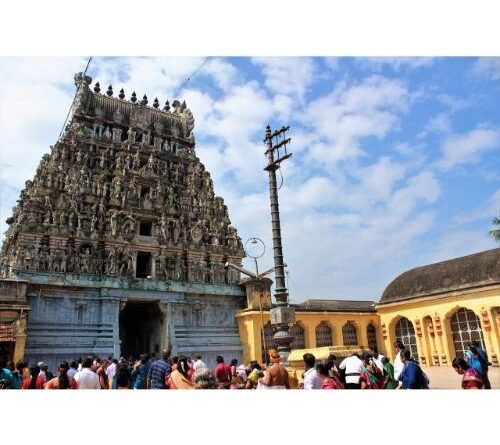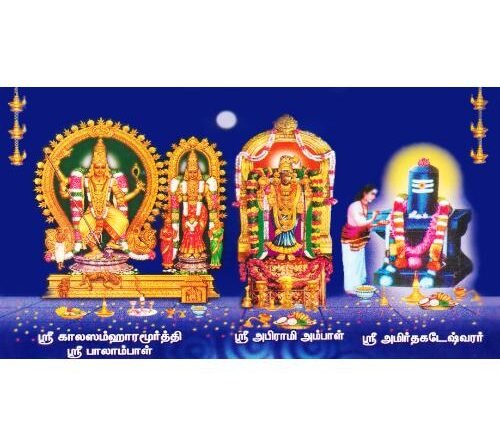Sri Abirami Amman Samedha Sri Amirthakadeswarar Devasthanam Thirukkadaiyur,Tamil Nadu
Amrithakadeeswarar Abhirami Temple (also called Abhirami temple is a Hindu temple dedicated to Shiva in his manifestation as Kalantaka and his wife Parvati as Abhirami. There is a Shrine for Maha Vishnu as Amrithanarayana and his consort Mahalakshmi as Amrithavalli. It is located in Thirukkadaiyur (Thirukkadavur), 21 km East of Mayiladuthurai, Tamil Nadu in India. This temple is associated with the legend of Shiva saving his young devotee, Markendeya from death, and the tale of a saint, Abirami Pattar a devotee of the presiding goddess.
The presiding deity is revered in the 7th-century-CE Tamil Saiva canonical work, the Tevaram, written by Tamil saint poets known as the nayanars and classified as Paadal Petra Sthalam.The temple complex covers 10 acres and has two gateway towers known as gopurams. The tallest is the eastern tower, with 11 stories and a height of 46 metres (151 ft). The temple has numerous shrines, with those of Amirthaghateswarar and Abhirami being the most prominent. The temple has six daily rituals at various times from 5:30 a.m. to 10 p.m., and twelve yearly festivals on its calendar. The present masonry structure was built during the Chola dynasty in the 9th century, while later expansions are attributed to Thanjavur Nayaks. The temple is maintained and administered by the Dharmapuram Aadhenam.
As per Hindu legend, Shiva is believed to have destroyed eight different demons and the eight Ashta Veeratanam temples are built signifying each of his victories. The temple is counted one of the eight where Shiva is believed to have appeared as Kalasamharamurthy to save Markandeya from the death clutches of Yama. Based on the legend of Markandeya, it is believed that worshiping at this temple will give longevity to couples who have reached age sixty or eighty-one and such worship is common in the temple.
Brahmapureeswarar Temple at Thirukadaiyur Mayanam or Brahmapureeswarar Temple Thirumeiganam, Pillaiperumalnallur, another famous Padal Petra Shiva Sthalam is located nearby, easterly.
History
There are several inscriptions in the temple belonging to the Medieval Cholas. On the southern wall in the central shrine, there is an inscription from the 13th regnal year of Rajaraja I indicating stipulation of paddy to the temple by a merchant in return to offer of land to the temple offered. Another record in the temple indicates the record (ARE 242 of 1925) of a gift of paddy to the temple by Rajendra Chola for conducting eight-day temple festival annually. A third record on the same wall indicates record dated to 1054 CE from the reign of Rajadhiraja Chola records a gift of land by a devotee to feed 17 devotees. The fourth record (ARE 244 of 1925) in the shrine from the period of Kulothunga Chola I indicates the Mahasabha of Tirukadavur selling 1.74 velis of land that had been lying fallow for 50 years. An interesting inscription from the outer precinct from the period of Rajaraja II indicates confiscation of lands from a custodian of a temple who colluded with Vaishanvites (worshipers of Vishnu). There are several inscriptions indicating donations for performing art, drama, dance and music. The temple is maintained and administered by the Dharmapuram Adheenam.
Legend
Thirukkadaiyur derives its name from the pot, called Gatam in Tamil. Vishnu, Indra, and the other Devas needed a sublime place to consume the ambrosia that had been churned during the Samudra manthan and, therefore, brought the ambrosia pot here. Before consuming it, they forgot to worship Ganesha, who is to be worshiped before any great undertaking. Ganesha, hurt and offended at the unintentional slight by the devas, stole the pot of Amrita and hid it at Tirukkadaiyur. Ganesha created a Shiva Lingam, dedicated to his father and mother, and poured some of the Amrita over it. The Shiva Lingam at this temple is known as Amrita Ghat Eshwarar, which, translated from Sanskrit literally means “Lord that leads to immortality” (‘Immortality’ (Amrita) ‘Step’ (Ghat) ‘Lord’ (Eshwarar)). It is also believed that Abhirami incarnated here by the power of Vishnu.
As per popular legend, near the temple of Tirukkadaiyur, there lived a sage named Mrikandu and his wife Marudmati. They were both devotees of Shiva and worshiped him day and night for many years, asking to be graced with a child. After many years of penance, Shiva appeared to Mrikandu and Marudmati. He told them that he heard their prayers and would give them a choice: they could either have a gifted son who would live to be only sixteen, or a son of low intelligence who would live a long life. Mrikandu and Marudmati chose the former, and were blessed with Markandeya, an exemplary son, destined to die at the age of sixteen.
As Markandeya grew, so did his devotion to Shiva. As advised by his father, Markandeya worshipped the Shiva Lingam at Tirukkadaiyur, even bringing water from the Ganges to the temple via an underground passage. On the day he was destined to die, Yama, the deity of death, appeared with his noose to tie around the soul of Markandeya and take it with him. Markandeya sought refuge in the temple and embraced the Siva Lingam. Shiva appeared and warned Yama not to touch Markandeya, as he was under his protection. Yama refused to listen and threw the noose anyway, binding Markandeya and the Lingam together. Angered by Yama’s extraordinary arrogance, Shiva kicked him and held him under his foot, making Yama inactive. Markandeya was blessed by Shiva to remain sixteen years old eternally. Shiva came to be known as “Kala-samhara” (Sanskrit: “Destroyer of Time”) at this temple.
Meanwhile, with Yama being rendered inactive, there were no deaths on earth, but people were still being born. Burdened by the weight of so many people and unable to sustain their hunger, the earth-goddess, Bhumi Devi, appealed to Shiva for help. Shiva, feeling compassionate for the earth-goddess, released Yama, allowing death to occur again. However, in order to remind Yama never to try to kill someone while they are worshiping Shiva again, the icon of Shiva in this temple is depicted with his forefinger raised in warning.
Since it is believed that Lord Siva subdued Yama in Thirukkadaiyur, the Lord is called Mrityunjaya (Sanskrit: “Conqueror of Death” or “Victorious over Death”).















